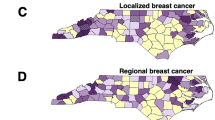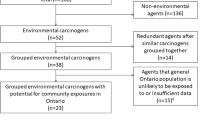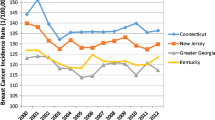Summary
Purpose. To investigate the role of environment in breast cancer development, we conducted an ecological study to examine the association of releases for selected industrial chemicals with breast cancer incidence in Texas.
Methods. During 1995–2000, 54,487 invasive breast cancer cases were reported in Texas. We identified 12 toxicants released into the environment by industry that: (1) were positively associated with breast cancer in epidemiological studies, (2) were Environmental Protection Agency (EPA) Toxics Release Inventory (TRI) chemicals designated as carcinogens or had estrogenic effects associated with breast cancer risk, and (3) had releases consistently reported to EPA TRI for multiple Texas counties during 1988–2000. We performed univariate, and multivariate analyses adjusted for race and ethnicity to examine the association of releases for these toxicants during 1988–2000 with the average annual age-adjusted breast cancer rate at the county level.
Results. Univariate analysis indicated that formaldehyde, methylene chloride, styrene, tetrachloroethylene, trichloroethylene, chromium, cobalt, copper, and nickel were positively associated with the breast cancer rate. Multivariate analyses indicated that styrene was positively associated with the breast cancer rate in women and men (β = 0.219, p =0.004), women (β = 0.191, p=0.002), and women ≥ 50 years old (β = 0.187, p=0.002).
Conclusion. Styrene was the most important environmental toxicant positively associated with invasive breast cancer incidence in Texas, likely involving women and men of all ages. Styrene may be an important breast carcinogen due to its widespread use for food storage and preparation, and its release from building materials, tobacco smoke, and industry.
Similar content being viewed by others
References
DM Parkin P Pisani J Ferlay (1999) ArticleTitleEstimates of worldwide incidence of 25 major cancers in 1990 Int J Cancer 80 827–841
SH Landis T Murray S Bolden PA Wingo (1998) ArticleTitleCancer statistics in 1998 CA Cancer J Clin 48 6–29
JV Lacey SS Devesa LA Brinton (2002) ArticleTitleRecent trends in breast cancer incidence and mortality Environ Mol Mutagen 39 82–88
TJ Key PK Verkasalo E Banks (2001) ArticleTitleEpidemiology of breast cancer Lancet 2 133–140
MP Madigan RG Ziegler J Benichou C Byrne RN Hoover (1995) ArticleTitleProportion of breast cancer cases in the United States explained by well-established risk factors J Natl Cancer Inst 87 1681–1685
B Rockhill CR Weinberg B Newman (1998) ArticleTitlePopulation attributable fraction estimation for established breast cancer risk factors: Considering the issues of high prevalence and unmodifiability Am J Epidemiol 147 826–833
JS Evans JE Wennberg BJ McNeil (1986) ArticleTitleThe influence of diagnostic radiography on the incidence of breast cancer and leukemia N␣Engl J Med 315 810–815
DB Thomas LM Jimenez A McTiernen K Rosenblatt H Stalsberg A Stemhagen WD Thompson MG Curnen W Satariano DF Austin RS Greenberg C Key LN Kolonel DW West (1992) ArticleTitleBreast cancer in men: risk factors with hormonal implications Am J Epidemiol 135 734–748
AW Hsing JK McLaughlin P Cocco Chein Co ParticleHT JF Fraumeni SuffixJr. (1998) ArticleTitleRisk factors for male breast cancer (United States) Cancer Causes Control 9 269–275
HT Sorenson S Friis JH Olsen AM Thulstrup L Mellemkjaer M Linet D Trichopoulos H Vistrup J Olsen (1998) ArticleTitleRisk of breast cancer in men with liver cirrhosis Am J Gastroenterol 93 231–233
SH Giordano AU Buzdar GN Hortobagyi (2002) ArticleTitleBreast cancer in men Ann Intern Med 137 678–687
National Research Council: Hormonally Active Agents in the Environment. National Academy Press, Washington, DC, 1999
J Russo YF Hu X Yang IH Russo (2000) ArticleTitleChapter 1: developmental, cellular, and molecular basis of human cancer J Natl Cancer Inst Monogr 27 17–37
SR Sturgeon C Schairer M Gail M McAdams LA Brinton RN Hoover (1995) ArticleTitleGeographic variation in mortality from breast cancer among white women in the United States J Natl Cancer Inst 87 1846–1853
AS Robbins S Brescianini Kelsey JL (1997) ArticleTitleRegional differences in known risk factors and the higher incidence of breast cancer in San Francisco J Natl Cancer Inst 89 960–965
F Laden D Spiegleman LM Neas GA Colditz SE Hankinson JE Manson C Byrne BA Rosner FE Speizer DJ Hunter (1997) ArticleTitleGeographic variation in breast cancer incidence rates in a cohort of US women J Natl Cancer Inst 89 1373–1378
AW Prehn DW West (1998) ArticleTitleEvaluating local differences in breast cancer incidence rates: a census-based methodology (United States) Cancer Causes Control 9 511–517
P Reynolds S Hurley DE Goldberg H Anton-Culver L Bernstein D Deapen PL Horn-Ross D Peel R Pinder RK Ross D West WE Wright A Ziogas (2004) ArticleTitleRegional variations in breast cancer among California teachers Epidemiology 15 746–754
U.S. Environmental Protection Agency. What is the Toxics Release Inventory (TRI) Program. http://www.epa./gov/tri/what is. htm (23 November 2004)
U.S. Environmental Protection Agency. Toxics Release Inventory Program. http://www.epa.gov/tri/ (23 November 2004)
J Chakraborty (2004) ArticleTitleThe geographic distribution of potential risks posed by industrial toxic emissions in the US J Environ Sci Health Part A Tox Hazard Subst Environ Eng 39 559–575
L Wunderlich (1995) An Overview of the Uses of the Toxics Release Inventory Data in the U.S US Environmental Protection Agency (US. EPA), Office of Pollution Prevention and Toxics (OPPT) Washington, DC
AL Dent BM Fowler GM Kaplan GM Zarus WD Henriques (2000) ArticleTitleUsing GIS to study the health impact of air emissions Drug Chem Toxicol 23 161–178
CM Neumann DL Forman JE Rothlein (1998) ArticleTitleHazard screening of chemical releases and environmental equity analysis of populations proximate to toxic release inventory facilities in Oregon Environ Health Perspect 106 217–226
KP Cantor PA Stewart LA Brinton M Dosemeci (1995) ArticleTitleOccupational exposures and female breast cancer mortality in the United States J Occup Environ Med 37 336–348
J Hansen (1999) ArticleTitleBreast cancer risk among relatively young women employed in solvent-using industries Am J Ind Med 36 43–47
PR Band ND Le R Fang M Deschamps P Yang (2000) ArticleTitleIdentification of occupational cancer risks in British Columbia. A population-based case–control study of 995 incident breast cancer cases by menopausal status, controlling for confounding factors J Occup Environ Med 42 284–310
U.S. Environmental Protection Agency. EPA TRI. OSHA Carcinogens. http//www.epa.gov/tri/chemical/oshacarc.htm (23 November 2004)
MB Martin R Reiter T Pham YR Allellanet J Camara M Lahm L Pentecost K Pratap BA Gilmore S Divekar RS Daguta JL Bull A Stoica (2003) ArticleTitleEstrogen-like activity of metals in mcf-7 breast cancer cells Endocrinology 144 2425–2436
ZG Jia (1991) ArticleTitleAnalysis of serum levels of selenium, zinc, and copper in 132 patients with malignant tumors Zhonghua Yu Fang Yi Xue Za Zhi 25 205–207
ID Capel MH Pinnock DC Williams IW Hanham (1982) ArticleTitleThe serum levels of some trace and bulk elements in cancer patients Oncology 39 38–41
Margalioth EJ, Schenker JG, Chevron M: Copper and zinc levels in normal and malignant tissues. Cancer 52: 868–872, 1983
SM Vaidya PL Kamalakar (1998) ArticleTitleCopper and ceruloplasmin levels in serum of women with breast cancer Ind J Med Sci 52 184–187
JA Garofalo H Ashkari ML Lesser C Menendez-Botet S Cunningham-Rundels MK Schwartz RA Good (1980) ArticleTitleSerum zinc, copper, and CU/Zn ratio in patients with benign and malignant breast lesions Cancer 46 2682–2685
SK Gupta VK Shukla MP Naidya SK Roay S Gupta (1991) ArticleTitleSerum trace elements and Cu/Zn ratio in breast cancer J Surg Oncol 46 178–181
C Yenisey M Fadilogu B Onvural (1996) ArticleTitleSerum copper and ceruloplasmin concentrations in patients with primary breast cancer Biochem Soc Trans 24 321S
National Toxicology Program. National Toxicology Program Annual Plan 2002 (NIH Publication No. 03–5309). U.S. Department of Health and Human Services, Rockville, MD, 2002
International Agency for Research on Cancer. IARC’s Mission. Cancer Research for Cancer Control. http://www.iarc.fr/eng/general/index.html (23 November 2004)
Agricultural Health Study. Study Background. http://www. aghealth.org/background.html (2 December 2004)
MD Gammon MS Wolff AI Neugut SM Eng SL Teitelbaum JA Britton MB Terry B Levin SD Stellman GC Kabat M Hatch R Senie G Berkowitz HL Bradlow G Garbowski C Maffeao P Montalvan M Kemeny M Citron F Schnabel A Schuss S Hajdu V Vinceguerra N Niguidula K Ireland RM Santella (2002) ArticleTitleEnvironmental toxins and breast cancer on Long Island. II. Organochlorine compound levels in blood Cancer Epidemiol Biomark Prev 11 686–697
Texas Department of Health: change in population standard for age-adjusted rates. Dis Prev News 60(5): 1–5, 2001
RN Anderson HM Rosenberg (1998) Age standardization of death rates: implementation of the year 2000 standard National Center for Health Statistics Hyattsville, MD
The North American Association of Central Cancer Registries. Cancer in North America Publications. NAACCR Combined Incidence Rates. http://www.naaccr.org/index.asp?Col_SectionKey=11 & Col_ContentID=50 (7 December 2004)
United States Census 2000. Texas QuickFacts from the US Census Bureau. http://www.quickfacts.census.gov/qfd/states/48000.html (23 November 2004)
The North American Association of Central Cancer Registries. Cancer in North America Publications. Section III: Age-adjusted Cancer Incidence for the NAACCR (U.S.) Combined by Sex and Hispanic/Latino Ethnicity, 1995–2000. http://www.naaccr.org/index.asp?Col_SectionKey=11 & Col_ContentID=50 (7 December 2004)
United States Census 2000. Census 2000. Urban and Rural Classification. http://www.census.gov/geo/www/ua/ua_2k.html (23 November 2004)
United States Environmental Protection Agency. How Are the Toxics Release Inventory Data Used? (EPA-260-R-002–004), Office of Information Analysis and Access, Washington D.C, 2003
U.S. Environmental Protection Agency. Toxics Release Inventory Program. 2002 TRI Press Materials. TRI Total Disposal or Other Releases, 1988–2002. http://www.epa.gov/tri/tridata/tri02/press/press.htm (23 November 2004)
SAS Institute Inc.: SAS (Program) Version 9.0. SAS Institute, Cary, NC, 2004
Center for Disease Control. Agency for Toxic Substances and Disease Registry. ToxFAQs for Styrene. http://www.atsdr. cdc.gov/tfacts53.html (26 October 2004)
United States Environmental Protection Agency. Technology Transfer Network Air Toxics Website. Styrene. http://www. epa.gov/ttn/atw/hlthef/styrene.html (26 October 2004)
E Demole D Berthet (1979) ArticleTitleA chemical study of Burley tobacco flavour (Nicotiana tabacum L.) I. Volatile to medium-volatile constituents (b. p. ≤ 84° C/0.001 Torr) Helv Chim Acta 55 1866–1882
International Agency for Research on Cancer: IARC Monographs on the Evaluation of Carcinogenic Risks to Humans. Styrene. IARC, Lyon, 2002
SM Rappaport K Yeowell-O’Connell W Bodel JW Yager E Symanski (1996) ArticleTitleAn investigation of multiple biomarkers among workers exposed to styrene and styrene-7,8-oxide Cancer Res 56 5410–5416
K Ohno Y Azuma S Nakano T Kobayashi S Hirano Y Nobuhara T Yamada (2001) ArticleTitleAssessment for styrene oligomers eluted from polystyrene-made food containers for estrogenic effects in in vitro assays Food Chem Toxicol 39 1233–1241
O Wong (1990) ArticleTitleA cohort mortality study and a case–control study of workers potentially exposed to styrene in the reinforced plastics and composites industry Br Ind J Med 47 753–762
M Matanoski- Francis A Correa-Villasenor E Elliot C Sautos-Burgoa L Schwartz (1993) ArticleTitleCancer epidemiology among styrene- butadiene rubber workers IARC Sci Publ 127 363–374
O Wong ST Lisa MD Whorton (1994) ArticleTitleAn updated cohort mortality study of workers exposed to styrene in the reinforced plastics and composites industry Occup Environ Med 51 386–396
M Kogevinas G Ferro A Andersen T Bellander M Biocca D Coggon V Gennaro S Hutchings H Kolstad I Lundberg E Lynge T Partanen R Saracci (1994) ArticleTitleCancer mortality in a historical cohort study of workers exposed to styrene Scand J Work Environ Health 20 251–261
HA Kolstad K Juel J Olsen E Lynge (1995) ArticleTitleExposure to styrene and chronic health effects: mortality and incidence of solid cancers in the Danish reinforced plastics industry Occup Environ Med 52 320–327
AM Ruder EM Ward M Dong AH Okun K Davis-King (2004) ArticleTitleMortality patterns among workers exposed to styrene in the reinforced plastic boatbuilding industry: an update Am J Ind Med 45 165–176
KG Darrall JA Figgins RD Brown GF Phillips (1998) ArticleTitleDetermination of benzene and associated volatile compounds in mainstream cigarette smoke Analyst 123 1095–1101
SL Miller S Branoff WW Nazaroff (1998) ArticleTitleExposure to toxic air contaminants in environmental tobacco smoke: an assessment for California based on personal monitoring data J Expo Anal Environ Epidemiol 8 287–311
A Morabia (2002) ArticleTitleSmoking (active and passive) and breast cancer: epidemiologic evidence up to June 2001 Environ Mol Mutagen 39 89–95
PD Terry TE Rohan (2002) ArticleTitleCigarette smoking and the risk of breast cancer in women: a review of the literature Cancer Epidemiol Biomarkers Prev 11 953–971
S Kropp J Chang-Claude (2002) ArticleTitleActive and passive smoking and risk of breast cancer by age 50 years among German women Am J Epidemiol 156 616–626
L Gordis (2000) Epidemiology EditionNumber2nd W.B. Saunders Company Philadelphia
T Colton R Greenberg K Noller L Ressquie C Bennekam Particlevan T Heeven Y Zhang (1993) ArticleTitleBreast cancer in mothers prescribed diethylstilbesterol in pregnancy. Further follow-up JAMA 269 2096–2100
Author information
Authors and Affiliations
Corresponding author
Rights and permissions
About this article
Cite this article
Coyle, Y.M., Hynan, L.S., Euhus, D.M. et al. An ecological study of the association of environmental chemicals on breast cancer incidence in Texas. Breast Cancer Res Treat 92, 107–114 (2005). https://doi.org/10.1007/s10549-004-8268-z
Issue Date:
DOI: https://doi.org/10.1007/s10549-004-8268-z




